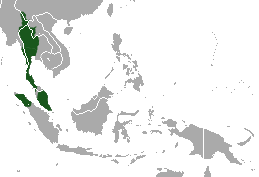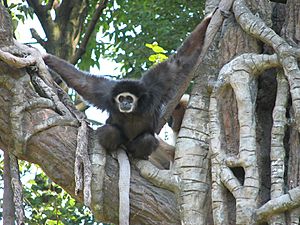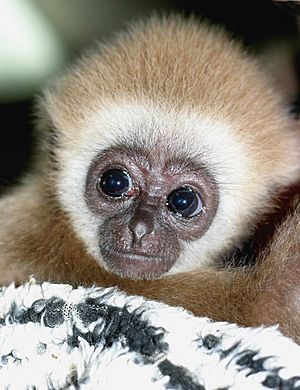White-handed gibbon facts for kids
Quick facts for kids Lar gibbon |
|
|---|---|
 |
|
| Pair | |
| Conservation status | |
| Scientific classification | |
| Kingdom: | |
| Class: | |
| Order: | |
| Family: | |
| Genus: | |
| Binomial name | |
| Hylobates lar (Linnaeus, 1771)
|
|
 |
|
| Lar Gibbon range | |
The lar gibbon, also known as the white-handed gibbon, is a type of primate from the gibbon family. You might have seen them in zoos because they are one of the more famous gibbons.
Their fur can be many colors, from black and dark brown to light brown or sandy shades.
Lar gibbons are active during the day (this is called diurnal). They live in rainforests and spend most of their time in trees (this is called arboreal). Family groups live in a specific area called a territory. They protect their territory from other gibbons by making loud calls.
Contents
What Lar Gibbons Look Like
The fur color of a lar gibbon can be black, dark brown, light brown, or sandy. Their hands and feet are white, and a ring of white hair goes around their black face. Both male and female gibbons can have any of these colors, and they are also very similar in size.
Gibbons are amazing at swinging through trees using their arms. This movement is called brachiation. Because of this, white-handed gibbons have curved fingers, long hands, super long arms, and shorter legs. This helps them move quickly and easily through the forest canopy. Like all apes, they do not have a tail.
Where Lar Gibbons Live
Lar gibbons live in many places, more than any other gibbon species. You can find them in Indonesia, Laos, Malaysia, Myanmar, and Thailand. In the past, they also lived in southwest China. Their home is in tropical rainforests. They can also be found in the northwest part of the island of Sumatra.
In recent years, the areas where lar gibbons live have become smaller and more spread out. They are probably no longer found in China, or if they are, only a very small number remain in southwest Yunnan.
Lar gibbons usually live in lowland forests and hill forests, often below 1200 meters (about 3,900 feet) above sea level. Large rivers often separate different types of gibbons. Lar gibbons live in southern and eastern Myanmar, but only east of the Salween River. They are also found throughout the Malay Peninsula and west of the Mekong River in northwestern Laos and northern Sumatra.
Lar gibbons share their homes with other primates like orangutans, siamangs, and different types of monkeys. In Thailand, there are likely between 15,000 and 20,000 lar gibbons.
What Lar Gibbons Eat
Lar gibbons mostly eat fruit, which makes up about half of their diet. They also eat leaves (about 29%), insects (about 13%), and flowers (about 9%). In the wild, they eat many different foods, including figs, other small sweet fruits, berries, young leaves, buds, and new shoots. They also eat insects like mantises and wasps, and sometimes even birds' eggs. During summer, when fruits and leaves are harder to find, they eat a lot more insects.
Lar Gibbon Behavior
Lar gibbons are active during the day and live in trees in rainforests. They are usually active for about 8.7 hours each day. They leave their sleeping spots around sunrise and go back to their sleeping trees about 3.4 hours before sunset.
On average, lar gibbons spend their days:
- Eating (32.6%)
- Resting (26.2%)
- Traveling (24.2%)
- Doing social activities (11.3%)
- Making calls (4.0%)
- Having encounters with other gibbon groups (1.9%)
They rarely come down to the ground. Instead, they use their long arms to swing through the trees. Their hooked hands help them move quickly and with a lot of speed from branch to branch. If they do come to the ground, they walk on two legs with their arms raised above their heads for balance.
Lar gibbons usually live in small family groups. These groups have one male and one female who are a breeding pair, along with their young. When a young gibbon grows up and is ready to have its own family, it leaves its parents' group.
Lar Gibbon Calls
Family groups have their own specific territory. They protect this area by making loud calls to warn off other gibbons. Every morning, the family gathers at the edge of their territory and starts a "great call." This is a duet, or a song, sung by the breeding pair. Each type of gibbon has its own special call, and each pair has unique variations of that call.
The great call of the lar gibbon includes many short hoots mixed with more complex hoots. It also has a "quavering" sound at the beginning and end. These calls help scientists tell different gibbon species apart. Recent studies show that gibbon songs might also be used to warn others about predators like tigers, leopards, eagles, and pythons. When these predators are nearby, their songs are more likely to have sharp "wow" sounds than their normal duets.
Reproduction and Life Cycle
A female lar gibbon is pregnant for about six months. Usually, only one baby is born at a time. The young gibbons drink their mother's milk for about two years. They become fully grown at around eight years old. In the wild, lar gibbons can live for about 25 years.
Images for kids
See also
 In Spanish: Gibón de manos blancas para niños
In Spanish: Gibón de manos blancas para niños







